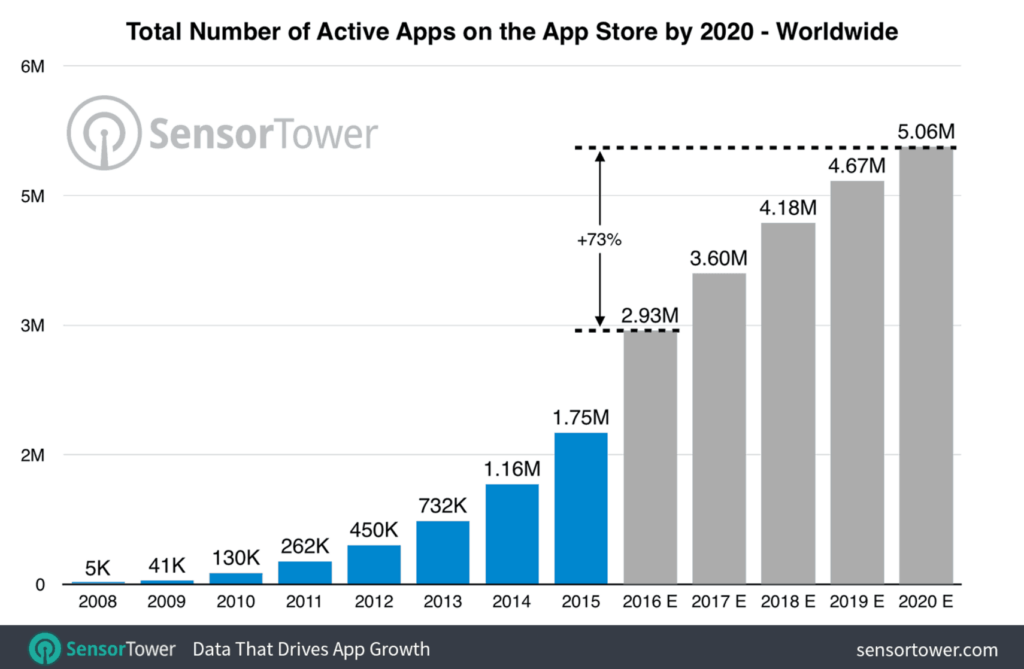Ever wonder how some teams create brilliant onboarding experiences, perfect user flows and mobile app launches that would make a rocket jealous…
…yet your app is struggling to get off the ground?
Maybe you’ve hit a roadblock after trying to plan your app on your own, or maybe you’ve struggled to find a way to communicate your vision. Maybe the lack of momentum is leading you to believe that the entire app development process might not be worth it.
Trust me: It is. Take a look at these stats about mobile today:
- The app economy’s future is bright, and we expect worldwide gross consumer spend to surpass $139 billion in 2021. (App Annie)
- In Q1 of 2017, iOS and Google Play downloads grew 15 percent year over year—to nearly 25 billion worldwide. (App Annie)
- In 2017, the average U.S. adult will spend two hours, 25 minutes per day using mobile apps (eMarketer)
So what’s the difference between teams who take advantage of these market trends and those who come up a little short? It’s the ability to embrace a simple concept:
Planning with a purpose.
As you develop a mobile app, you need to start with a clear understanding of what you’re building and why. The best way to uncover these insights is to start your app development process with a few simple steps that will help you create a purposeful product plan—a plan that gives your team clear direction going forward.
Let’s look at the steps you need to take to ensure that you’re starting your project off on the right foot. These five steps will help you regain momentum and design a user-friendly, habit-forming app.
Study Your Target Audience
The best apps start with the user in mind.
But it’s not enough to just think about your end user. You need to take the time to truly understand what makes them tick and what role your app will play in their life.
True understanding can only happen if you’re willing to invest time upfront for that purpose. Talk to people who look like your ideal user. Browse the online communities they frequent to gain insight into what they want as a group. There are myriad creative ways to navigate the process of studying your target audience, but the key is that you do it, and do it thoroughly.
One of the biggest mistakes that businesses make when building apps is jumping into development or design without any research. Research can help you build a better product and ensure that your app experience is crafted to serve your target audience.
Here’s how we help brands plan their apps: Mobile App Blueprint
Understand The Existing Market

It’s probably fair to suggest that there’s already an app out there created for any target market you can think of. The app market is filled with millions of apps that are used by millions of people all over the world on a daily basis. Before building your prototype, find out which apps your target audience is already using and learn from the experiences your potential users are having with these apps.
When you analyze the existing market, you don’t want to make the mistake of studying only your direct competitors. The reality of today’s world is that your competition isn’t always in the same market as you—and those in the same market may not even have an app experience worth studying. You want to get inspiration from the best in the world and compare your app design to the best designs out there.
One great approach to understanding your market is to look at the top apps within your category. For example, if you’re launching a new mobile banking app, download and review the top apps in the Finance section of the Apple App Store. Of course, you also need to evaluate your direct competition, but viewing your competition as an entire category will give you the advantage you need to stand out.
Leverage Qualitative Data From App Reviews
A major opportunity for improving your prototype can be found in the reviews for your competition’s apps. When customers leave a review on an app (especially in Google Play), their comments tend to be in-depth, specific and very valuable. Reading their reviews can give you the insights you need to stand out in the industry and attract a more satisfied user base.
As you begin the process of creating your mobile app, leverage app reviews to better understand what your competition is doing right and what they’re doing wrong. If you see one specific complaint cropping up over and over again, it’s on you to ensure that this knowledge is incorporated into your prototype. Take advantage of the opportunities your competitors are ignoring, whether it’s a requested feature or battery drainage issues.
Collaborate With The Technical Team
Once you have gathered intel on your audience, the market, your competition and potential opportunities, it’s time to join forces. A lot of designers make the mistake of working in a silo when the best approach for developing a great plan is collaborating with your technical team.
At this stage in the process, you’re not actually coding, but it’s important that you learn what’s possible and what isn’t. You’ll want to share your plan with stakeholders and investors with the confidence that you can deliver. You don’t want to make promises about what you’re planning to build and then launch the app with features missing because you didn’t consult the technical team.
Communicate with your team and communicate often. If you feel like you’re overcommunicating with the team, keep doing what you’re doing—constant contact makes your team feel like they can speak up when something isn’t quite right and also makes them feel more involved when it comes time to execute.
Embrace The Right Tools
You wouldn’t build a house without the right tools, so why would you try to build a prototype without them?
Make sure that you’re using the right tools when you begin prototyping your mobile app. The best prototyping tools for your company will depend on your experience with the options available and how much you know about design and development. Some builders will want to embrace more advanced tools, but they’re not the right fit for every business. For your company, the best tool may simply be a drag-and-drop prototyping service—and that’s completely OK.
Find the tools that work for you, and don’t feel as if you’re not as good as the next company solely because they’ve decided to use something else.
Wrapping Things Up
Based on the recent and rapid growth of mobile, it’s obvious that launching an app can be one of the biggest new revenue streams for an organization.
So don’t waste your time creating an app that doesn’t serve your user base. Plan with a purpose. Start by understanding your target audience and taking the steps to build an app that people will come back to for months to come.
Want to learn more about mobile app planning and how to create a product that stands out? Check out our latest guide: The Ultimate Guide To User Experience Design.



